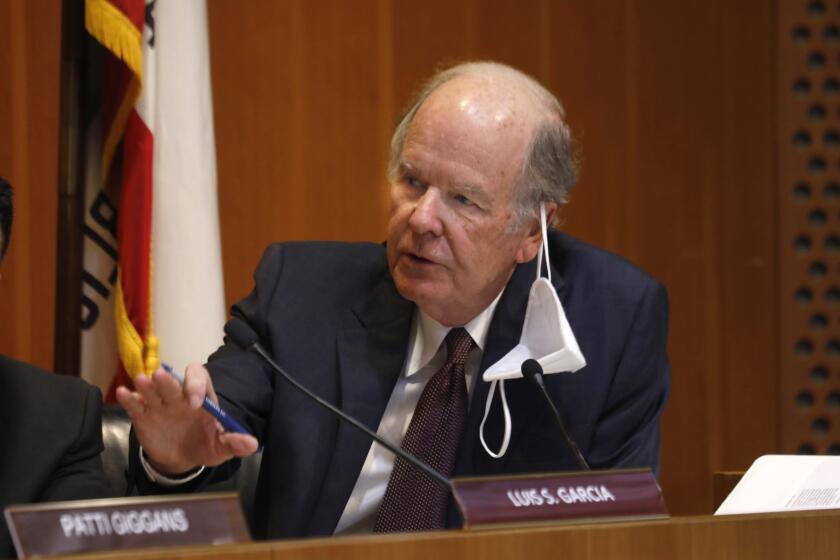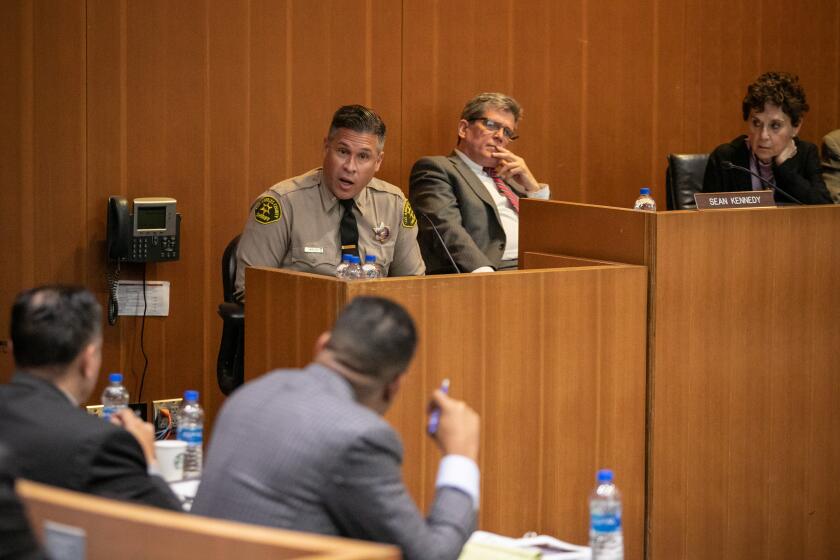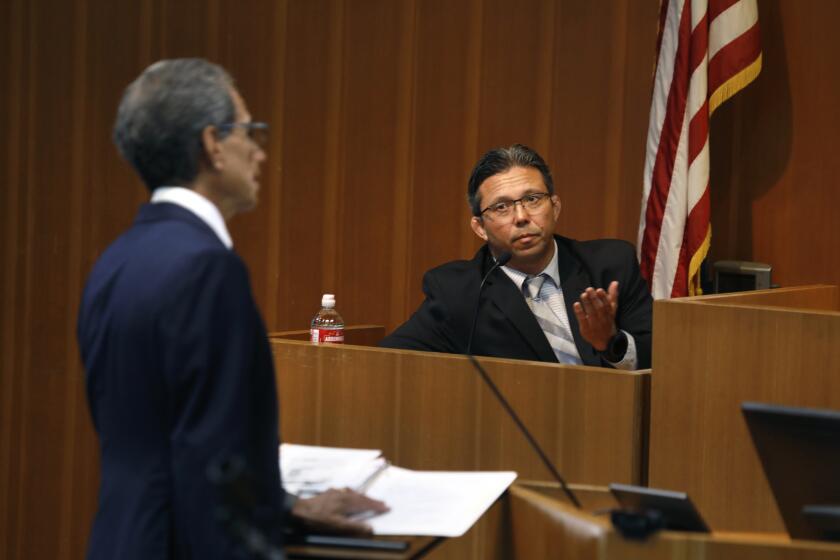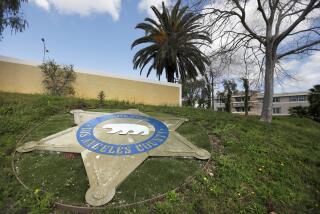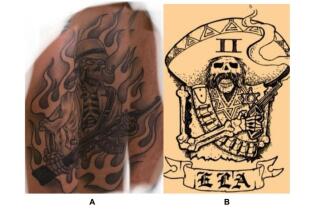Column: Banning violent deputy gangs in the L.A. Sheriff’s Department is essential. But is it constitutional?
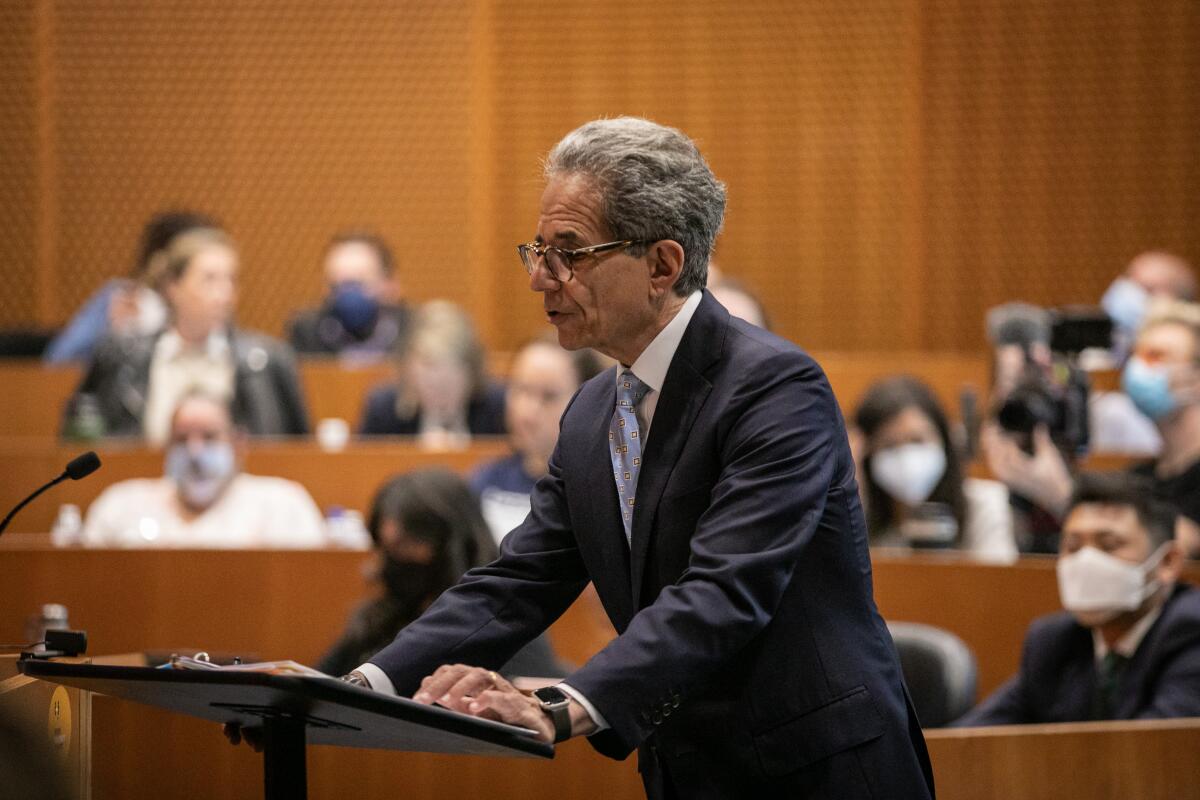
- Share via
For at least 50 years, the Los Angeles County Sheriff’s Department has been plagued by secretive “deputy gangs” — organized subgroups of deputy sheriffs who allegedly engage in violence, corruption and illegal activity. And for almost as many years, reformers have hoped to eradicate those gangs, going back to the Kolts Commission 30 years ago, which called for them to be “rooted out.”
But they’re still with us, according to the report by special counsel Bert Deixler, which was released by the Sheriff Civilian Oversight Commission earlier this month. Deixler and his team, after hearing from approximately 80 witnesses, concluded that at least half a dozen gangs or cliques operate in the department. They have names such as the Executioners, the Banditos, the Reapers and the Rattlesnakes; their members wear tattoos of skeletons, rifles, skulls and snakes.
Opinion Columnist
Nicholas Goldberg
Nicholas Goldberg served 11 years as editor of the editorial page and is a former editor of the Op-Ed page and Sunday Opinion section.
Members of these groups, the report says, have falsified reports, harassed colleagues, undermined department morale and violated citizens’ rights. They’ve taken control of many patrol stations through a “shadow” chain of command, and those who dare challenge them have been known to find rats on their doorsteps or to have the lug nuts on their wheels loosened.
Worst of all, they “valorize violence” and “exalt the use of excessive force.“
Everyone rational wants to eliminate these thuggish groups. But there’s a big outstanding question: Can it be done legally?
Deixler has proposed that Sheriff Robert Luna do what he says no sheriff has done before — establish an explicit policy prohibiting deputies from joining or belonging to gangs and banning tattoos that depict violence or other offensive iconography (or, for those who already have them, making it a rule that they must keep them covered).
But would those policies be allowed under the 1st Amendment of the U.S. Constitution, which protects freedom of speech and freedom of assembly and association?
A special counsel report found that at least half a dozen “gangs” or “cliques” of tattooed deputies are still active in the Sheriff’s Department, including the Regulators, Spartans, Gladiators, Cowboys and Reapers.
Some people are pretty sure they won’t.
“Good luck trying to impose something that’s going to violate the 1st Amendment rights of employees,” says former L.A. County Sheriff Alex Villanueva, who called Deixler’s report “a joke.”
Tattoos, he says, are a form of protected speech, and what’s more they have no correlation with misconduct. As for deputy subgroups, he seems to think that they’re mere social groups, and that if you ban the Banditos you might as well ban the women’s softball team too. There’s no “compelling interest” in overriding the constitutional rights of deputies, Villanueva says, to ban the so-called gangs.
A 2021 opinion by Southwestern Law School constitutional law professor John Tehranian, commissioned by the deputies union, agreed. It said that a prohibition on department employees participating in subgroups “impacts the ability of deputies to engage in expressive and associational activities” outside their jobs. Because of its “sweeping reach and the risks it poses to the free speech [and] associational ... rights of deputies,” a prohibition would be unlikely to withstand constitutional review, Tehranian wrote.
That’s a worrisome argument to be sure. It is part of what has stymied the fight against deputy gangs in the past.
But 1st Amendment rights are not unlimited, nor should they be.
Former and current Los Angeles sheriff’s officials testified Tuesday about so-called “deputy gangs” allegedly operating within the department.
I called Deixler to ask whether he thought the Constitution would pose a problem for rooting out the gangs.
“No, it won’t,” he said. He made a case that I found convincing — and that I hope will sway the courts in the event of a legal challenge.
Deixler argues that if the behavior in question — joining deputy gangs and wearing threatening tattoos as a sign of membership — is being done in connection with deputies’ government jobs, then the 1st Amendment is not an issue. Restrictions are allowable on work-related speech.
And even if a court decides that deputies in gangs are acting and speaking in their personal capacities as private citizens, then, under the Supreme Court’s 1968 decision in Pickering vs. Board of Education, the court would undertake a “balancing test” to determine whether the government’s legitimate interests in restricting that speech and behavior outweigh its employees’ 1st Amendment rights.
To win that argument, the Sheriff’s Department would need to show that the gangs are “disruptive to the internal operations” of the department and that the disruption is significant enough that it “impairs discipline … or harmony among co-workers” or “impedes the performance of the speaker’s duty,” Deixler’s report says.
A witness subpoenaed in the Civilian Oversight Commission’s investigative hearings on deputy gangs was ordered by the Sheriff’s Department not to testify.
Given what we know about these gangs, I don’t believe that would be terribly difficult to prove.
Courts have consistently found that law enforcement agencies have a “heightened need for order, loyalty, morale and harmony” — which allows them more latitude in restricting the speech of their officers. For instance, being a member of the Ku Klux Klan has been found to be a legitimate reason to fire a sheriff’s deputy.
If the Sheriff’s Department decides to implement Deixler’s proposals, a legal challenge seems likely. Surmounting it would not be a sure thing. But the credible reports of decades of egregious misbehavior by deputy gangs offer a very powerful argument.
It’s been 50 years since deputy gangs were first identified in the department; 30 since the Kolts Commission called for their eradication; 24 since the U.S. Commission on Civil Rights noted their effect on communities of color; 11 since the Citizens’ Commission on Jail Violence described their presence in the county jails; and two since the Rand Corp. and Loyola Law School documented their continued existence.
Other law enforcement agencies have had to deal with gangs in their ranks, but no other large police agency has permitted them to exist and flourish as they have in L.A., according to Deixler. Because there’s been no sustained effort to eradicate them, they remain embedded in the culture.
But this is a promising moment. Deixler’s recommendations — there are 27 in all — have the support of the county Board of Supervisors, which has urged Luna to implement them. Luna, after all, ran for office last year on a promise that he would do away with deputy gangs, and he has created a new Office for Constitutional Policing within the department to help him do so.
It’ll be a huge battle. But it’s time.
More to Read
A cure for the common opinion
Get thought-provoking perspectives with our weekly newsletter.
You may occasionally receive promotional content from the Los Angeles Times.

